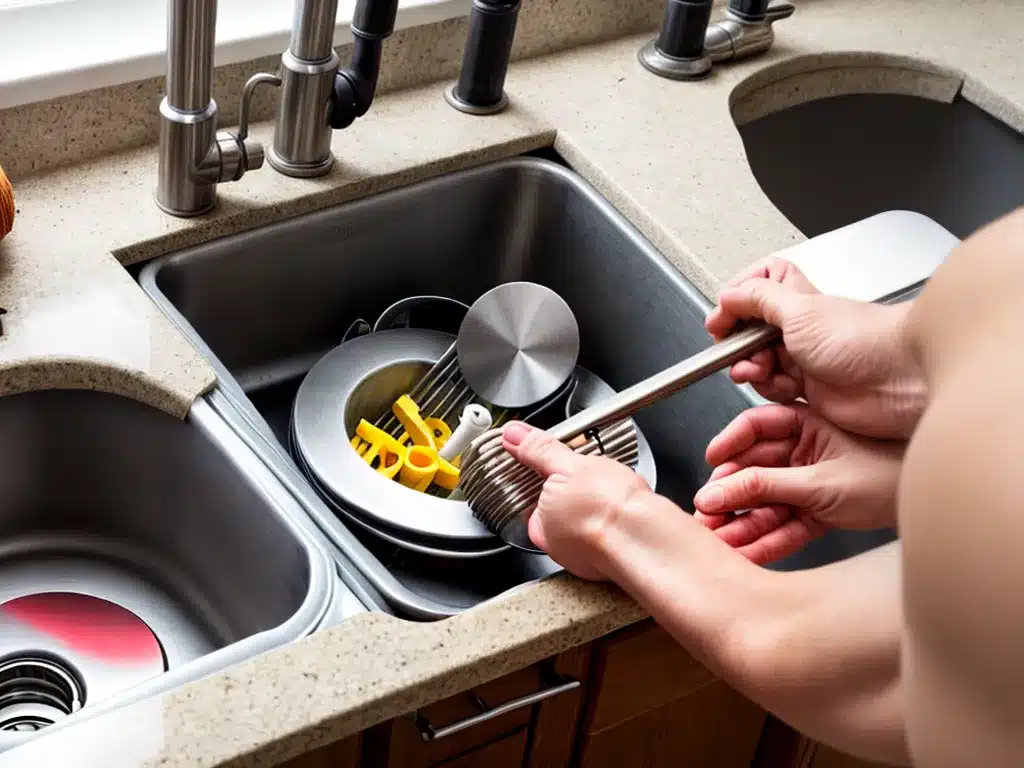Having issues with your garbage disposal? Hardware problems like jams, leaks, noises, and motor failures are common garbage disposal problems that can often be fixed with some troubleshooting and DIY repair. Here’s a comprehensive guide to diagnosing and fixing various garbage disposal hardware problems.
Identifying the Problem
The first step is to accurately identify the issue you’re experiencing. Here are some of the most common garbage disposal hardware problems:
Jammed Disposal
If the disposal completely stops working, doesn’t spin at all when turned on, or makes a humming sound, it is likely jammed. Jams are often caused by putting the wrong items down the disposal like bones, greasy foods, pasta, rice, or tough peels and skins.
To check for a jam, turn off the disposal and shine a flashlight down into the disposal chamber. Look for obstructing items lodged in the shredder ring or grinding plate. You may need to manually turn the shredder ring using an Allen wrench or special jam release tool.
Leaking Disposal
Check under and around the base of the disposal for water leaks. Leaks most often originate from:
- Cracks in the garbage disposal housing
- Failing seals around the mounting assembly, sink flange, or drain pipe connections
- Clogged dishwasher hose connections
Loud Noise
Strange noises like grinding, squealing, clanging, or loud humming when the disposal is running could indicate:
- Blunt shredder ring – Old food particles and grease have worn down the grinders over time.
- Damaged grinders or impellers – Hard items like bones, silverware, rocks, glass, or pop tabs have broken pieces inside the disposal.
- Misaligned impeller – Vibrations from a shifted impeller.
- Bad motor bearings – Worn out motor parts are causing friction.
Disposal Won’t Turn On
If the disposal is completely dead and unresponsive, the internal motor or wiring have likely failed. This will require replacement parts.
If the disposal hums but doesn’t spin when turned on, this indicates a seized or stuck motor that needs repair.
Fixing a Jammed Disposal
Jams are relatively easy for a DIYer to fix. Here are the steps:
-
Turn off the garbage disposal and unplug it.
-
Insert an Allen wrench into the bottom of the disposal. Turn it back and forth to manually rotate the shredder ring and release jammed debris.
-
Use tongs or pliers to pull out any remaining clogged items in the disposal chamber. Avoid putting your fingers inside a running disposal.
-
Push the reset button on the bottom center of the disposal unit if your model has one.
-
Plug the disposal back in and turn on the power. Run cold water and turn on the disposal to flush leftover particles down the drain.
Tip: Prevent future jams by running plenty of cold water before and during the disposal operation and avoiding putting non-food items into it.
Fixing Leaks
Follow these troubleshooting tips for fixing disposal leaks:
-
For housing cracks, apply waterproof epoxy adhesive to seal the leak. Replace any cracked sections or the entire housing if damage is extensive.
-
Tighten mounting bolts, hose clamps, and P-trap connections. Use thread tape on drain pipes and gaskets on flanges.
-
Clear clogs and kinks in dishwasher hoses. Disconnect and clean out the dishwasher connection port if needed.
-
Install a new mounting gasket or flange seal kit to repair a leak at the sink drain.
Replacing Worn Shredder Blades
Blunt shredder blades reduce grinding power and cause irritation noise. Here’s how to replace the blades:
-
Disconnect power and drain water from the disposal.
-
Insert an Allen wrench in the bottom center shaft and rotate the shredder ring until you can see the blades.
-
Remove the old blades by loosening the screws. Pry off or cut through stubborn ones if necessary.
-
Install new stainless steel blades and tighten the mounting screws evenly.
-
Spin the shredder ring to ensure smooth rotation. Reconnect and test the disposal.
Repairing a Damaged Impeller
Follow these steps to realign or replace a broken impeller:
-
Unplug the disposal and drain the sink trap. Remove the disposal housing to expose internal parts.
-
Inspect the impeller for cracks or misalignment. Realign it on the motor shaft if needed.
-
Replace damaged impellers. Make sure the new impeller can rotate freely.
-
Reassemble the disposal, plug it in, and test it. The impeller should not vibrate or rub against the housing.
Replacing a Bad Disposal Motor
If the motor is humming loudly or won’t run, follow this process:
-
Unplug the disposal and disconnect drain pipes and wiring. Support the disposal weight before removing mounting bolts.
-
Tip the disposal over to access the motor on the underside. Release the motor mount and slide the motor off the drive shaft.
-
Install a replacement motor with matched specifications and mount it into place. Reconnect the wiring harness and grounding wire.
-
Reassemble the disposal components and remount the unit. Make sure to get a tight seal with the sink flange gasket.
Test run the new motor to verify smooth operation before reconnecting pipes underneath.
When to Call a Professional
While many disposal repairs are DIY-friendly, it’s best to call a professional for:
-
Complete motor failures requiring extensive disassembly.
-
Electrical problems with the wiring or wall switch/outlet.
-
Bad grinding noises indicating internal damage.
-
Complex leaks requiring sink or counter removal.
-
Replacing corroded or damaged sink flanges.
Properly diagnosing the specific issue and following these troubleshooting tips can help you safely fix many common garbage disposal hardware problems! Let me know if you have any other garbage disposal repair questions.













